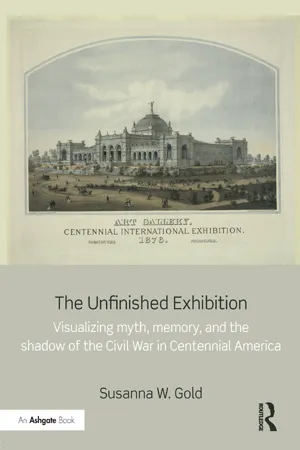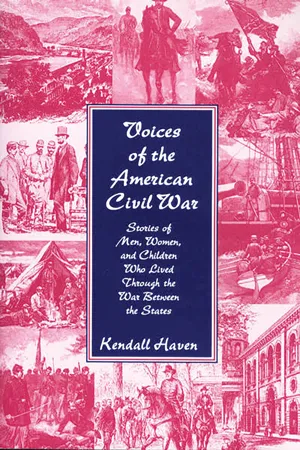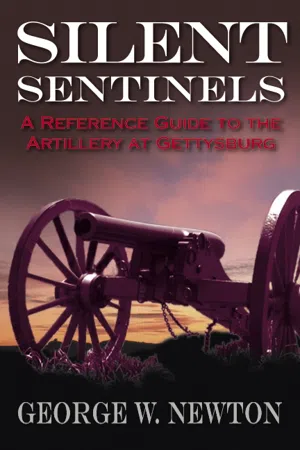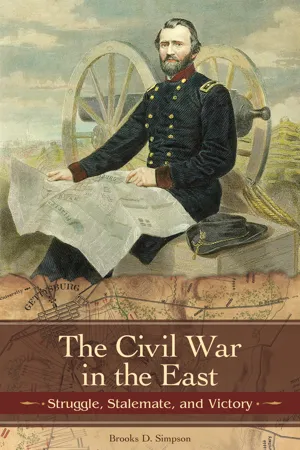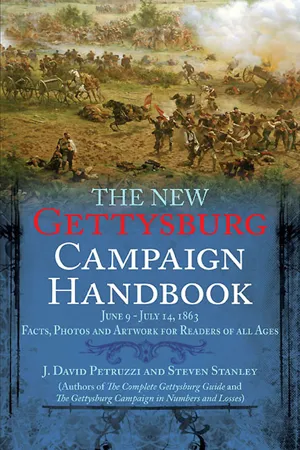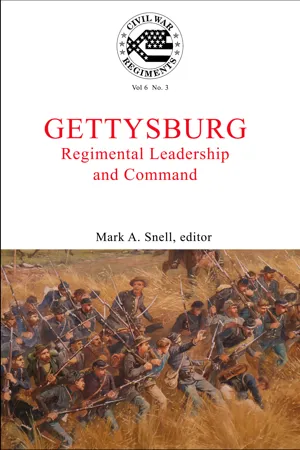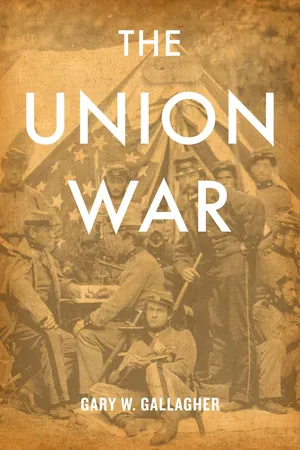History
Battle of Gettysburg
The Battle of Gettysburg was a major turning point in the American Civil War, fought from July 1 to July 3, 1863, in Gettysburg, Pennsylvania. It was the largest battle ever fought in North America and resulted in a Union victory, halting General Robert E. Lee's invasion of the North. The battle is often considered a critical moment in the war and a significant victory for the Union.
Written by Perlego with AI-assistance
Related key terms
1 of 5
8 Key excerpts on "Battle of Gettysburg"
- eBook - ePub
Famous Battles and How They Shaped the Modern World, 1588–1943
From the Armada to Stalingrad
- Beatrice Heuser, Athena S. Leoussi(Authors)
- 2020(Publication Date)
- Pen & Sword Military(Publisher)
Chapter 7
Gettysburg, 1863, and American National Identity
Georg Schild
This uniting of North and South in a renewed American nationalism was a fine thing, to be sure, but all too often it was characterized by forgetting what the war had been about.James McPherson, Hallowed Ground(New York: Crown, 2003), p. 45In early July 1863, two years into the American Civil War, two large armies faced each other in the small southern Pennsylvania town of Gettysburg. There was the Union army, officially called the Army of the Potomac, commanded by General George Gordon Meade, and the Army of Northern Virginia, led by the legendary Robert E. Lee. Their engagement in Gettysburg was one of the largest and bloodiest battles of the war. Roughly 90,000 Northerners faced 70,000 Southerners. Of these 160,000 men, some 44,000 were killed, wounded or taken prisoner.The Battle of Gettysburg is still very much alive in the American collective memory because it was so bloody and because Southern mythology claims that the Confederates had almost won the confrontation due to their superior virtue and exceptionally brave fighting abilities. And if they had won Gettysburg, perhaps they could have also won the war and their independence. The Gettysburg battle is one of the few cases where the defeated came to dominate the historiography of the confrontation. Southerners turned the defeat into a mythological struggle. Such a reframing of the narrative came at a price, however. In the collective memory of the Southern states, the causes of the war have been almost completely eradicated. Fighting for secession and for maintaining slavery did not fit into a post-war societal discourse of bravery and eventually, national unity.Secession and War
The American Civil War is arguably the most thoroughly researched topic in all of human history. There are numerous eyewitness accounts of many of the battles, and generations of historians have gone over every detail of the confrontation. There is an agreement about the basic course of events during the Civil War and including the Battle of Gettysburg. The war commenced in the spring of 1861 after eleven Southern states had declared their secession from the Union. There can be no doubt that slavery was at the heart of that decision. The Southern states feared that a majority of northerners would sometime in the future declare slavery unconstitutional and would thereby undermine the economic basis of the Southern way of life. Faced with the choice of preserving slavery or maintaining the union, Southern whites chose the former. President Abraham Lincoln, who had been elected to office in November 1860, rejected the notion that states had a right to secede. In his inaugural address of March 1861, he declared unequivocally that ‘the Union of these States is perpetual.1 - eBook - ePub
The Unfinished Exhibition
Visualizing Myth, Memory, and the Shadow of the Civil War in Centennial America
- Susanna W. Gold(Author)
- 2016(Publication Date)
- Routledge(Publisher)
The painting’s subject has become lodged in the American imagination as the turning point not only of the Battle of Gettysburg, but also of the Civil War itself, when over twelve thousand Confederate soldiers confronted Union troops on the afternoon of July 3, 1863, only to be brutally defeated in violent bloodshed that left over five thousand dead. 3 Depicting a sea of Rebel soldiers advancing from the right and colliding in deadly combat with their Yankee foes, The Battle of Gettysburg offers a muddled confusion of fighting and fallen bodies, raised rifles, ready cannon, and fiery blasts in a flat, barren landscape at the foot of low, rolling hills. Beneath the thick cloud of gun smoke that fills the air, these once gentle green hills resemble angry, active volcanoes, echoing the hostile aggression of battle. Within this landscape, Rothermel emphasizes the vicious struggle between men—the violence of the bayonet charge, the rage of those who raise their weapons against the enemy with brows furrowed and jaws clenched in passionate fury, and littering of the battleground with suffering, injured men and corpses. 4 “[T]he picture is not a picture of heroism,” described one Centennial review. “It is a picture of blood and fury,. . . of brother-men, of fellow citizens—murdering one another in the lust of hate; of soldiers, brave men of the South and North, in the spasms of mortal agony; of dead men with blue faces and swollen hands— horrors piled on horrors.” 5 This violence was amplified in the Centennial galleries where Rothermel’s canvas hung with its lower edge near the floor, causing the array of dead, dying, and decaying corpses that lay sprawled or crumpled over the bottom edge of the canvas to confront the viewer at eye level - eBook - PDF
Voices of the American Civil War
Stories of Men, Women, and Children Who Lived Through the War Between the States
- Kendall Haven(Author)
- 2002(Publication Date)
- Libraries Unlimited(Publisher)
Research these four Union soldiers and discover their lives and accomplishments both before and after Gettysburg. • Our annual celebration of Thanksgiving has an important link to Gettysburg. Research the history of this annual celebration to see how our modern celebra- tion began by presidential decree after this historic battle. • The town of Gettysburg was devastated by the battle. One day il was a pros- perous farming town; the next it was trampled, chopped down, ar d shot up by massive warring armies. When the armies left, the civilian population was left to tend the broken bodies, bury the mounds of dead, patch their town and shat- tered fields, and piece their lives back together. Research the experience of this town and other Civil War towns that were the sights of major battles (Fredericksburg, Sharpsburg, Petersburg, Atlanta, etc.). How d:d they each fare during and after battle? • Research the Gettysburg Address, a short speech made by President Abraham Lincoln. Why did he make it? Where did he make it? What was :he occasion that caused him to deliver it? What was unusual—even remarkable—about this speech at the time? How was the speech received when he presented it? 3. Make It Real • Gettysburg is a famous battle in part because of its sheer size. Approximately 140,000 men collided on the fields surrounding this small town of 2,400. How big is 140,000 soldiers? If 140,000 men stood side by side in one long row, how Home Town Horror / 189 long would that row be? (Assume each man with musket takes 2.5 feet of linear space.) Pickett's charge involved 15,000 soldiers all advancing on one small spot in the Union line. - eBook - ePub
Silent Sentinels
A Reference Guide to the Artillery at Gettysburg
- George Newton(Author)
- 2005(Publication Date)
- Savas Beatie(Publisher)
Chapter 1
The Gettysburg Campaign: An Overview
The American Civil War was entering its third year when the Gettysburg Campaign began. West of the Appalachian Mountains (generally referred to as the Western Theater), Union forces during the war’s first two years experienced a string of solid successes. Union armies firmly controlled Kentucky and occupied large portions of Tennessee. Major land victories included Forts Henry and Donelson, Shiloh, New Orleans, Perryville (a strategic success, and a tactical draw) Stones’ River, and others. Major cities had been captured, including New Orleans, Memphis, and Nashville. By the middle of May 1863, Union Major General U.S. Grant had driven Southern forces in Mississippi into the defenses of Vicksburg, which he then besieged. Much of the Mississippi River, a critically important logistical lifeline for both combatants, was in Union hands except for a narrow stretch between Vicksburg and Port Hudson, Louisiana. Unfortunately for the South, the latter city was also threatened by a large Union army and would fall later that summer.In the Eastern Theater, however, the Union had few gains worthy of public boasting. After the Confederates scored a clear victory at Manassas during the war’s inaugural summer, the Army of the Potomac moved to within sight of the Southern capital at Richmond, only to be driven away with heavy losses by General Robert E. Lee and his Army of Northern Virginia. Elevated to command after a severe wound knocked General Joseph E. Johnston from the field at Seven Pines, Lee lived up to his pre-war promise and had audaciously assumed the offensive against Maj. Gen. George McClellan. After driving him away from Richmond in late June and early July 1862, Lee moved north into northern Virginia and decisively defeated Major General John Pope and the Army of Virginia at Second Manassas that August. His next move, however, was stopped by McClellan at Sharpsburg in the war’s bloodiest single day of fighting on September 17, 1862. The Maryland Campaign was a clear strategic defeat for the Confederacy, which had hopes of foreign recognition. Two months later Lee scored another tactical victory, this one a wholly defensive affair at Fredericksburg against yet another Union commander, Major General Ambrose Burnside. After a miserable effort in the winter mud went awry in early January 1863, Burnside was replaced by Major General Joseph Hooker. - eBook - PDF
The Civil War in the East
Struggle, Stalemate, and Victory
- Brooks D. Simpson(Author)
- 2011(Publication Date)
- Praeger(Publisher)
Within weeks he shifted the army east of the Blue Ridge Mountains. Of the campaign he remarked: “The army did all it could. I fear I required of it impossibilities. But it responded to the call nobly and cheerfully, and though it did not win a victory it conquered a success.” 25 In years to come the Gettysburg campaign in general and the battle for Gettysburg in particular would be celebrated as the “high watermark” of the Confederacy and, sometimes in conjunction with Vicksburg, termed the “turning point of the war.” It was no such thing. The chances for Confederate victory remained much as they were before the campaign; at most the Army of Northern Virginia had suffered losses that would be increasingly hard to replace. Nor had victory made the Army of the Potomac and its generals more confident about their chances of defeating the Confederate’s foremost military leader. Had the battle or the campaign turned out differently, what followed might have proved decisive, but as it happened, Gettysburg settled little. August 1863 found the Army of Northern Virginia and the Army of the Potomac facing each other in central Virginia once more. OVERSHADOWED OPPORTUNITIES In focusing on Lee’s invasion of Pennsylvania, his defeat at Gettysburg, and his escape to Virginia, accounts of military operations in the East in mid-1863 tend to overlook other actions, which, had they turned out differently, might have had an important impact on the progress of Union arms. Foremost in terms of its possible impact on public opinion was a series of efforts to take Charleston, South Carolina. In the fall of 1862 there had been talk of taking Wilmington, North Carolina, thus shutting down a major Confederate port. - eBook - ePub
The New Gettysburg Campaign Handbook
Facts, Photos, and Artwork for Readers of All Ages, June 9–July 14, 1863
- J. David Petruzzi, Steven Stanley(Authors)
- 2022(Publication Date)
- Savas Beatie(Publisher)
The Southern defeat at Gettysburg, combined with the loss of Vicksburg, Mississippi, was a serious double blow to the Confederate cause. The Southern armies marched and fought for nearly two more long years until the final surrenders in April and May of 1865.Order of Battle, July 1 – 3, 1863T he Order of Battle for the July 1–3 combat at Gettysburg is available from a wide variety of sources, but as discerning students discover, these often vary. What follows is based upon years of careful research in original archival sources. We think (and hope) they are the most complete and accurate to date, and that you find them useful.The following designations are used to denote casualties: (w) = wounded (c) = captured (mw) = mortally wounded (k) = killedWhen identified subordinate officers took command for wounded commanders, they are listed in descending order. Sometimes, due to incomplete records (especially on the Confederate side), it is impossible to determine who assumed command.Battle of Gettysburg, Pa., July 1–3FEDERAL FORCESARMY OF THE POTOMACMaj. Gen. George G. Meade, CommandingARMY HEADQUARTERSMaj. Gen. Daniel Butterfield, Chief of Staff (w)Brig. Gen. Gouverneur K. Warren, Chief of Engineers (w)Brig. Gen. Henry J. Hunt, Chief of ArtilleryBrig. Gen. Seth Williams, Assistant Adjutant GeneralLt. Col. Joseph Dickinson, Adjutant General Staff (w)Brig. Gen. Rugus Ingalls, Chief QuartermasterCol. Edmund Schriver, Inspector GeneralDr. Jonathan Letterman, Medical DirectorCol. George H. Sharpe, Bureau of Military InformationLt. John R. Edie, Acting Chief Ordnance Officer (acting)Provost MarshalBrig. Gen. Marsena R. Patrick93rd New York InfantryCol. John S. Crocker8th United States Infantry (eight companies)Capt. Edwin W. H. Read2nd Pennsylvania CavalryCol. R. Butler Price6th Pennsylvania Cavalry, Companies E and ICapt. James StarrCavalry detachments from 1st, 2nd, 5th,and 6th Regiments United States CavalryHeadquarters Guards and OrderliesOneida (New York) CavalryCapt. Daniel P. MannSignal CorpsCapt. Lemuel B. NortonEngineer BrigadeBrig. Gen. Henry W. Benham - eBook - ePub
A Journal of the American Civil War: V6-3
Gettysburg: Regimental Leadership and Command
- Mark A. Snell, Theodore P. Savas(Authors)
- 2021(Publication Date)
- Savas Publishing(Publisher)
29Reflecting upon the remarkable events that had descended upon his community, the reporter for The Gettysburg Compiler believed that he and the people of Gettysburg had witnessed “a scene the like of which is not recorded anywhere on the pages of the world’s history.” Gettysburg, the sight of one of America’s greatest tragedies, had played host to an important step in healing the wounds of the country’s Civil War. It was, the reporter continued, “a scene which no spectator, much less participant, can ever forget.”30No one realized it at that moment, but this first meeting of the Blue and Gray at Gettysburg forever transformed the battlefield to something more than the site of a great and terrible struggle and the place where Lincoln had uttered his famous speech. It had taken on a new meaning as a site fitting and proper to symbolize peace in a united nation. In 1888, the 25th anniversary of the battle, a larger reunion of the North and South would take place, and in 1913, Gettysburg would play host to the largest reunion of Union and Confederate veterans ever held. The reconciliation of North and South did not come without a high price. The North had fought the war in part to win what Lincoln hoped would be a land where “all men are created equal.” The price of reconciliation was for white America to deny black Americans that equality. Black Americans were shouldered aside while the whites made peace with one another. As ugly and shameful as this page in our history is, the handshake that occurred over the stone wall at Gettysburg in 1887 had to happen for the United States to become the nation it is today. Instead of raising a cynical eyebrow and condemning its participants as shortsighted and unwilling to face the real issues of the war they had fought, we should rejoice that there were men with courage enough in their hearts to make peace with their enemies. They set a high standard for us all to follow. - eBook - PDF
- Gary W. Gallagher(Author)
- 2011(Publication Date)
- Harvard University Press(Publisher)
Popular historians have created a body of work overwhelmingly fo-cused on armies and generals that routinely neglects, or ignores alto-gether, the larger political and social implications of military campaigns. They describe strategic maneuvering by generals seeking to place their opponent at risk. Once combat begins, officers and soldiers shed blood profligately for supremacy on previously insignificant bits of the Ameri-can countryside. Union troops fall by the thousands in a small cornfield owned by farmer D. R. Miller close to Antietam Creek in Maryland, set a ghastly standard of slaughter near a backwoods Methodist church in Tennessee called Shiloh, and leave a harvest of bodies in a jumble of rocks named Devil’s Den by local residents in southern Pennsylvania. Some of the most celebrated commanders in American military history dominate much of this Civil War. Ulysses S. Grant mounts a dazzling campaign against Vicksburg, reducing that Rebel stronghold overlook-ing the Mississippi River on July 4, 1863. Fourteen months after that pivotal event, William Tecumseh Sherman, who owes his success almost 122 The Armies entirely to Grant’s reassuring influence, delivers a powerful body blow to the Confederacy when he captures Atlanta. Hard on the heels of Sher-man’s success, Philip H. Sheridan rides to the battlefield at Cedar Creek to reverse an earlier tide of defeat and demoralization.Told and retold by every generation since the Confederate surrender in the spring of 1865, this Civil War—marked by honor and hubris, triumph and failure, and gallantry and perfidy on an epic scale—comes closer to serving as an American Iliad than any other element of our national past. 4 The second of these two Civil Wars emanates, for the most part, from scholars in an academic setting. Here the focus is on the home fronts, on the ways in which the conflict affects, or does not affect, the daily rhythms of life on farms and in cities.
Index pages curate the most relevant extracts from our library of academic textbooks. They’ve been created using an in-house natural language model (NLM), each adding context and meaning to key research topics.

